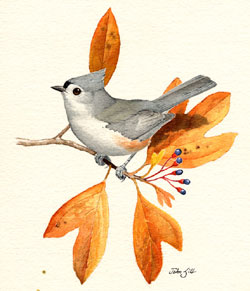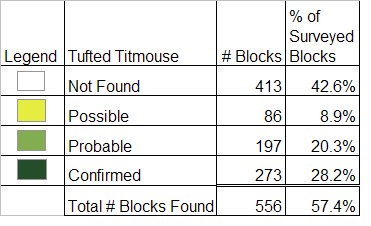Find a Bird - BBA1
Breeding Bird Atlas 1 Species Accounts
Tufted Titmouse
Parus bicolor
Egg Dates
May 14 to July 15
Number of Broods
one; may re-lay if first attempt fails.

Like a number of other primarily southern species, the Tufted Titmouse has undergone a substantial northward range expansion in the last 50 years. Not even listed as an official state bird by Griscom and Snyder (1955), the species made an abrupt appearance in the state in 1959. In that year, the Springfield Christmas Count found 4 titmice followed by 38 in 1960 and 67 in 1961. Entry into the state apparently occurred mainly via the Connecticut River valley. From 1963 onward, the Massachusetts Audubon Society documented the spectacular range expansion into Massachusetts by a statewide census conducted each February. By 1970, the titmouse population was well established in most of its present state range.
During the Atlas period, the Tufted Titmouse was confirmed as a nester over most of the state but was encountered much less frequently in the central uplands of northern Worcester County and on the Berkshire escarpment westward through the Berkshires to the New York State line. It was also less frequent on Cape Cod and absent entirely from Martha’s Vineyard and Nantucket.
The titmouse’s loud melodic whistles of four to eight phrases, often rendered peter-peter-peter, peto-peto-peto, or here-here, may be heard in any month of the year. Both sexes sing. They also have a varied repertoire of notes, including a harsh day-day-day and some resembling the wheezy calls of the Black-capped Chickadee. Pairs may form in any season, with separation from winter flocks as early as February. Pairs reportedly mate for life.
Titmice inhabit deciduous, especially oak, forest, riparian woodlands, and residential areas. They are cavity nesters, frequenting both living and dead trees. Nests are found in rotted-out knotholes, old woodpecker holes, and occasionally in less orthodox sites such as metal pipes, fence posts, cylindrical mail boxes, and bird houses of suitable dimensions. Nests are reported from 3 to 90 feet above the ground. Five Massachusetts nests were located as follows: 1 in a poplar cavity, 1 in a maple cavity, 1 in a Gray Birch stump, 1 in a dead tree, and 1 in a screech-owl box. Heights ranged from 3 to 40 feet (CNR).
Nest building begins in late April, when birds may be seen carrying nesting material. Old leaves, strips of bark, bits of moss, and grass are all used to fill the cavity, with the nest bowl itself typically lined with hairs. It has been remarked frequently that titmice have a liking for human hair and have been known to snatch hairs from people seated quietly nearby. Nest construction takes 6 to 11 days. There are four to eight (typically five to six) eggs, and the female does most of the incubation for 13 to 14 days. Nestlings remain in the cavity 15 to 18 days and have been recorded in Mass-achusetts from May 28 to July 31 (CNR, Meservey). Family groups with young being fed by adults have been encountered from June 24 to August 14 (Meservey, CNR, Ober).
Immatures may accompany the adults for several months. Family groups roam through the woods, sometimes joining large multi-species flocks. Although the titmouse is generally nonmigratory, movements are known to occur, and rather large, loose flocks sometimes develop in the fall and wander extensively. Banded individuals over seven years of age have been reported.
Map Legend and Data Summary
Atlas 1 data collected from 1975-1979


Note: common in deciduous woodlands; absent in higher elevations and on the Islands
Rudolph H. Stone



